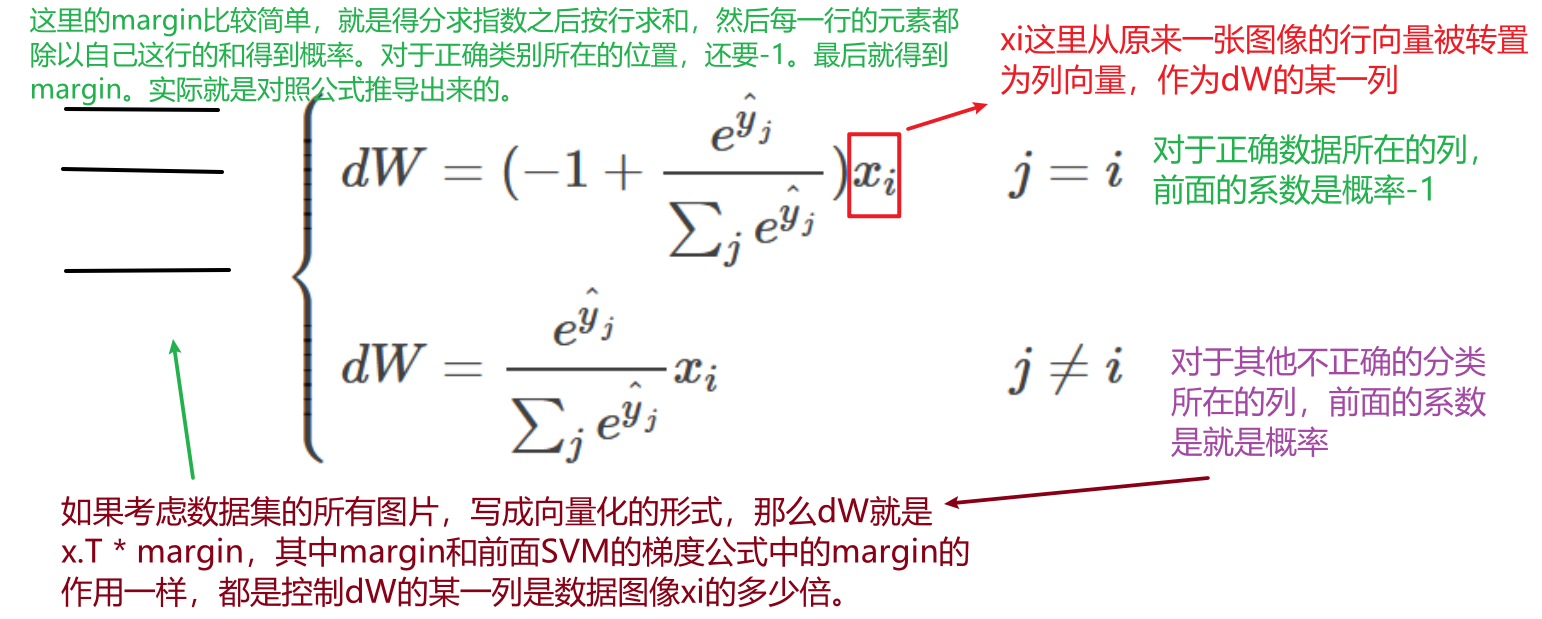1.Softmax损失函数和梯度求导
1.1.理论推导
参考:CS231n课程学习笔记(三)——Softmax分类器的实现
? 对于某张图片Xi来说,损失函数的定义:

? 对于求导来说,需要用到链式法则,即

? 对于某张图片数据Xi,由于Scores = W * x,所以对W求导比较简单,结果就是x.T,注意这里最好严谨一点写成x.T,而不是x。
? 而loss对score的求导,由于fj或者fyi分别在分母或者分子上,也就是并不同在分子或者分母上,所以需要分开求导。
-
j ! = y i j != y_i j!=yi? 此时是对非正确项的分母的各个fj求导:
-
j = = y i j == y_i j==yi? 此时是对正确项的分字 f y i fy_i fyi?求导:

? 最后的结果如下:

-
思考总结:到这里可以发现规律,就是求导的结果都是 d W = x . T ? m a r g i n dW = x.T * margin dW=x.T?margin,这个margin就是由得分函数来确定的,比如得分函数是SVM或者Softmax,具体margin的形式可以由公式先推导一张图片数据xi的形式,然后得到的公式对应的就是margin中的某一行的数据表达方式。并且这个margin正确类别和不正确类别的表达是有区别的,对应就是margin中正确类别所在的位置的数据和其他位置的数据是不一样的。
-
另外网上看到的另一个softmax求导的计算,写的比较简介规范:

1.2.编程实现
1.2.1.循环模式
def softmax_loss_naive(W, X, y, reg):
"""
Softmax loss function, naive implementation (with loops)
Inputs have dimension D, there are C classes, and we operate on minibatches
of N examples.
Inputs:
- W: A numpy array of shape (D, C) containing weights.
- X: A numpy array of shape (N, D) containing a minibatch of data.
- y: A numpy array of shape (N,) containing training labels; y[i] = c means
that X[i] has label c, where 0 <= c < C.
- reg: (float) regularization strength
Returns a tuple of:
- loss as single float
- gradient with respect to weights W; an array of same shape as W
"""
# Initialize the loss and gradient to zero.
loss = 0.0
dW = np.zeros_like(W)
#############################################################################
# TODO: Compute the softmax loss and its gradient using explicit loops. #
# Store the loss in loss and the gradient in dW. If you are not careful #
# here, it is easy to run into numeric instability. Don't forget the #
# regularization! #
#############################################################################
# *****START OF YOUR CODE (DO NOT DELETE/MODIFY THIS LINE)*****
num_classes = W.shape[1]
num_train = X.shape[0]
for i in range(num_train):
scores = X[i].dot(W)
scores -= np.max(scores) # 这里是-最大值,防止出现指数爆炸
correct_class = y[i]
exp_scores = np.exp(scores) # 得分求指数
loss += -np.log(exp_scores[correct_class]/np.sum(exp_scores))
for j in range(num_classes):
if j == correct_class:
# 一定注意下面是+=,因为这是循环遍历每张图片的方式,最后得到的是所有图片的梯度求平均,所以这里没遍历一张图片就把求出来的梯度加起来。
dW[:, j] += (exp_scores[j]/np.sum(exp_scores)-1) * X[i]
else:
dW[:, j] += (exp_scores[j]/np.sum(exp_scores)) * X[i]
loss /= num_train
loss += reg*np.sum(W*W)
dW /= num_train
dW += 2*reg*W
# *****END OF YOUR CODE (DO NOT DELETE/MODIFY THIS LINE)*****
return loss, dW
1.2.2.向量化模式
def softmax_loss_vectorized(W, X, y, reg):
"""
Softmax loss function, vectorized version.
Inputs and outputs are the same as softmax_loss_naive.
"""
# Initialize the loss and gradient to zero.
loss = 0.0
dW = np.zeros_like(W)
#############################################################################
# TODO: Compute the softmax loss and its gradient using no explicit loops. #
# Store the loss in loss and the gradient in dW. If you are not careful #
# here, it is easy to run into numeric instability. Don't forget the #
# regularization! #
#############################################################################
# *****START OF YOUR CODE (DO NOT DELETE/MODIFY THIS LINE)*****
num_classes = W.shape[1]
num_train = X.shape[0]
scores = X.dot(W)
correct_class_scores = scores[np.arange(num_train),y] # 这种访问方式得到的数据就是一个向量
# print(correct_class_scores.shape) 这里得到的就是一个一维向量
exp_scores = np.exp(scores)
exp_scores_sum = np.sum(exp_scores,axis=1) # 这里得到的也是一个一维向量
loss += np.sum(np.log(exp_scores_sum)-correct_class_scores) # 这里用的是loss公式的变形体,方便求
loss /= num_train
loss += reg*np.sum(W*W)
margin = exp_scores / exp_scores_sum.reshape(num_train,1) # reshape是为了能够广播
margin[np.arange(num_train),y] += -1 # 更改正确类别所在的位,让值-1
dW = X.T.dot(margin) # 注意一定是x.T
dW /= num_train
dW += 2*reg*W
# *****END OF YOUR CODE (DO NOT DELETE/MODIFY THIS LINE)*****
return loss, dW
2.Inline questions
Inline Question 1
# First implement the naive softmax loss function with nested loops.
# Open the file cs231n/classifiers/softmax.py and implement the
# softmax_loss_naive function.
from cs231n.classifiers.softmax import softmax_loss_naive
import time
# Generate a random softmax weight matrix and use it to compute the loss.
W = np.random.randn(3073, 10) * 0.0001
loss, grad = softmax_loss_naive(W, X_dev, y_dev, 0.0)
# As a rough sanity check, our loss should be something close to -log(0.1).
print('loss: %f' % loss)
print('sanity check: %f' % (-np.log(0.1)))
Why do we expect our loss to be close to -log(0.1)? Explain briefly.
Y𝑜𝑢𝑟𝐴𝑛𝑠𝑤𝑒𝑟:YourAnswer: 因为选择的权重是符合正态分布的,最后log里面是exp(fyi)/sum(exp(fj)),由于是正态分布此时计算出来的各个类别的得分都是近似的,所以log里面的概率就接近0.1
Inline Question 2
提问:Suppose the overall training loss is defined as the sum of the per-datapoint loss over all training examples. It is possible to add a new datapoint to a training set that would leave the SVM loss unchanged, but this is not the case with the Softmax classifier loss.(判断)
翻译:假设总训练损失定义为所有训练示例中每个数据点损失的总和。 可以将新的数据点添加到训练集,这将使SVM损失保持不变,但是对于Softmax分类器损失而言,情况并非如此。
回答:有可能加的数据点对svm来讲比较好辨识,所以取max之后都是0,但是对于softmax而言,总会得到一个概率分布,然后算出交叉熵,换言之,softmax的loss总会加上一个量,即使是一个很小的量。
